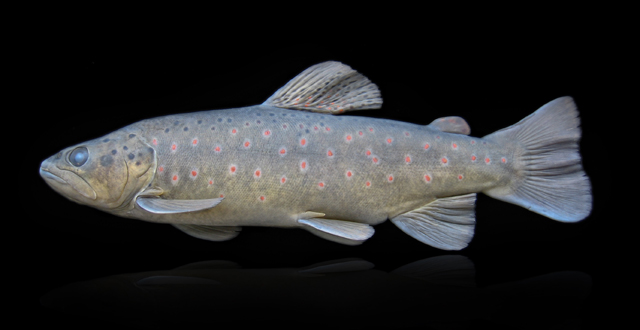| Salmonidae (Salmonids), subfamily: Salmoninae |
| 25 cm SL (male/unsexed) |
|
benthopelagic; freshwater |
| Asia: headwaters and upper reaches of the streams and rivers entering the Black Sea along its southeastern and southern coasts in Turkey, between Sakarya drainage in the west and Coruh drainage in the east. Apparently present in Georgia. |
|
Anal soft rays: 11-11; Vertebrae: 55-57. Distinguished from all its congeners in Turkey and adjacent areas by the combination of the following characters: small size, maximum length of about 25 cm SL; body brownish in life; black spots on body, small to medium (usually smaller than pupil), ocellated, restricted to back (missing in mid-dorsal area in front of dorsal fin) and to upper part of flank, few (decreasing in number with size); red spots few, small, ocellated, not very conspicuous, usually organized in three or four irregular longitudinal rows on median and lower part of flank, their appearance, size and number not changing with size; head long (27.8-31.1% SL in males, 25.3-27.4 in females), 1.2-1.4 times body depth at dorsal fin origin in male, distinctly sexually dimorphic; maxilla long (length 9.6-12.1 % SL in males, 8.6-9.8 in females), reaching beyond eye in both adults and juveniles, upper edge straight or slightly convex posteriorly in males; adipose fin slender, upper edge straight or very slightly convex anteriorly (Ref. 85599).
Description: dorsal fin with 3-4 simple and 9-11½ branched rays; anal fin with 3 simple and 8½ branched rays; pectoral fin with 1 simple and 12-14 branched rays; pelvic fin with 1 simple and 12-14 branched rays (Ref. 85599). |
| Occurs in small pools of streams with cold, clear and very swift flowing water, with high concentration of dissolved oxygen and substrate consisting of rocks, stones and few pebbles. Spends whole life and spawns in the upper reaches. Does not undertake migration during spawning period. Spawns in September-October. Overwinters into sand or gravel or under rocks and stones in small streams. Seems to stop feeding during winter as all specimens collected in winter had empty stomach (Ref. 85599). |
|
Least Concern (LC); Date assessed: 18 March 2013 Ref. (130435)
|
| harmless |
Source and more info: www.fishbase.org. For personal, classroom, and other internal use only. Not for publication.

